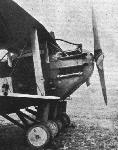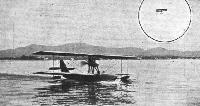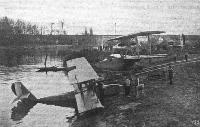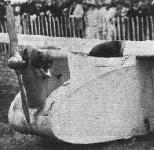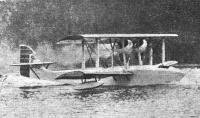Фотографии
-
THE "STAR TURN" AT THE R.A.F. PAGEANT: Below, a small military post defending an important railway bridge is attacked by Arabs, and escapes on a Vickers Troop-Carrier, sent to their assistance. Sopwith Snipes attack the enemy whilst the garrison emplane, and a demolition party place charges to destroy the bridge, which, as soon as the Troop-Carriers and escort get away, blows up, as shown above.
Самолёты на фотографии: Sopwith Snipe / 7F.1 - Великобритания - 1918Vickers Victoria - Великобритания - 1922
-
The Breguet type XIX A.2 Sesquiplan, with 450 h.p. Renault. A military machine of metal construction.
Самолёты на фотографии: Breguet Br.19 - Франция - 1922
-
Регистрационный номер: G-EBEZ [2] THE KING'S CUP: Mr. George Robey's D.H.9 before the start
Самолёты на фотографии: De Havilland D.H.9 - Великобритания - 1917
-
THE DE HAVILLAND FLYING SCHOOL: Some of the school machines in use lined up. In the foreground, the Avro-Renaults used for preliminary work, and farther back some of the D.H.9's, with "Puma" engines, on which more advanced instruction is given.
Самолёты на фотографии: Avro Type 548 - Великобритания - 1919De Havilland D.H.9 - Великобритания - 1917
-
Регистрационный номер: G-EBEZ [2], G-EBHA [2] THE KING'S CUP: The last three away. From right to left, Mr. George Robey's D.H.9 (450 Napier "Lion"), flown by Mr. A. J. Cobham, who came in second; Mr. J. D. Siddeley's Siddeley "Siskin" (325 Siddeley "Jaguar"), piloted by Mr. Frank T. Courtney, in whom was found the winner; Sir William Joynson-Hicks' Gloucestershire "Grebe" (325 Siddeley "Jaguar"), flown by Mr. L. L. Carter. This entry was the scratch machine.
Самолёты на фотографии: Armstrong Whitworth Siskin - Великобритания - 1921De Havilland D.H.9 - Великобритания - 1917Gloster Grebe - Великобритания - 1923
-
Регистрационный номер: G-EBEP THE RACE FOR THE KING'S CUP: Ten of the faster machines, arranged in the order of starting: 4, D.H.9 (230 h.p. Siddeley "Puma").
Самолёты на фотографии: De Havilland D.H.9 - Великобритания - 1917
-
SOME DERBY MACHINES: A.D.C. D.H.9a (450 h.p. Napier "Lion").
Самолёты на фотографии: De Havilland D.H.9A - Великобритания - 1918
-
Регистрационный номер: G-EBCG D.H.9a (350 h.p. Rolls-Royce "Eagle VIII").
Самолёты на фотографии: De Havilland D.H.9A - Великобритания - 1918
-
THE R.A.F. PAGEANT: A Handley Page O.400 brings an eventful day's proceedings to a close with final "Brock's Benefit," by discharging artificial cloud-screen bombs.
Самолёты на фотографии: Handley Page H.P.12 (O/400) - Великобритания - 1917
-
The S.I.A.I. (Savoia) S.16 Bis.M. flying boat, with 300 h.p. Fiat engine, one of many successful types of flying boats turned out by this Italian firm.
Самолёты на фотографии: SIAI S.16 / S.53 - Италия - 1919
-
The Dornier "Komet," a medium-powered commercial limousine monoplane, mainly of metal construction.
Самолёты на фотографии: Dornier Komet - Германия - 1921
-
Летающая лодка Delphin I
The Dornier "Delphin," a monoplane "cabin" flying boat of somewhat unusual design.Самолёты на фотографии: Dornier Delphin - Германия - 1920
-
Первый авиалайнер фирмы "Альбатрос" L.58
The Albatros "L.58" cabin monoplane: A commercial machine with cantilever wings and a 260 h.p. Maybach M.B.IV, or 260 h.p. Rolls-Royce "Falcon," engine.Самолёты на фотографии: Albatros L.57 / L.58 - Германия - 1922
-
The Vickers "Viking" Mark IV, amphibian flying boat, fitted with a 450 h.p. Napier "Lion."
Самолёты на фотографии: Vickers Viking / Type 54 - Великобритания - 1919
-
AT THE R.A.F. PAGEANT: Flight-Lieut. W. H. Longton, in partnership with his Avro, defies Newton, Einstein and Co. with his crazy and (inset, centre) inverted flying.
Самолёты на фотографии: Avro Avro 504 - Великобритания - 1913
-
Регистрационный номер: G-EBFK THE KING'S CUP: Mr. Hubert Scott-Paine's Supermarine "Sea Eagle" (360 Rolls-Royce "Eagle IX"), piloted by Capt. H. C. Biard. This fine craft, which flew so splendidly, had to suffer penalties through tyre trouble.
Самолёты на фотографии: Supermarine Sea Eagle - Великобритания - 1923
-
THE KING'S CUP: The Siddeley "Siskin," Courtney's winning mount, "on view" after the race.
Самолёты на фотографии: Armstrong Whitworth Siskin - Великобритания - 1921
-
Регистрационный номер: G-EBHA [2] THE TWO SIDDELEY "JAGUAR"-ENGINED MACHINES READY TO GET AWAY: Left, the Gloucestershire "Grebe," the scratch machine, and, right, Mr. J.D.Siddeley's "Siskin," which was piloted to victory by Mr. Frank T. Courtney.
Самолёты на фотографии: Armstrong Whitworth Siskin - Великобритания - 1921Gloster Grebe - Великобритания - 1923
-
AN AERIAL COMBAT AT THE R.A.F. PAGEANT: A Nieuport "Nighthawk" and a Boulton and Paul "Bourges" manoeuvring for a position of advantage. Inset on left, the "Bourges" is seen looping out of the "Nighthawk's" line of fire.
Самолёты на фотографии: Boulton Paul Bourges / P.7 - Великобритания - 1918Nieuport & General Nighthawk - Великобритания - 1918
-
Регистрационный номер: F2905 AT THE R.A.F. PAGEANT: The Boulton and Paul all-metal "Bourges," fitted with two Napier "Lions."
Самолёты на фотографии: Boulton Paul Bourges / P.7 - Великобритания - 1918
-
Регистрационный номер: M-MWAA Two views of the Dornier "Wall" monoplane flying boat, with two engines, arranged in tandem. Note, the "wheels" are not permanent fitments.
Самолёты на фотографии: Dornier Do.J Wal - Германия - 1922
-
The Albatros type 59/60 "sport" monoplane - complete with trousers. It has cantilever wings, and a 50-60 h.p. radial air-cooled engine.
Самолёты на фотографии: Albatros L.59 / L.60 - Германия - 1923
-
A "close-up" of the 1,000 h.p. Napier "Cub" in the Avro "Aldershot-Cub," which made its first public appearance at the R.A.F. Pageant.
Самолёты на фотографии: Avro Aldershot / Type 549 - Великобритания - 1922
-
Регистрационный номер: J6852 The Avro "Aldershot-Cub" long-distance bomber, fitted with a 1,000 h.p. Napier "Cub." This is the largest single-engined machine in the world.
Самолёты на фотографии: Avro Aldershot / Type 549 - Великобритания - 1922
-
THE RACE FOR THE KING'S CUP: Photographs of the competing machines. Avro "Viper" (200 h.p. Wolseley "Viper").
Самолёты на фотографии: Avro Type 552 - Великобритания - 1921
-
Регистрационный номер: C4541 The Armstrong-Siddeley "Siskin" single-seater fighter-scout, fitted with a 350 h.p. "Jaguar."
Самолёты на фотографии: Armstrong Whitworth (Siddeley) S.R.2 Siskin - Великобритания - 1919
-
Регистрационный номер: J6969 [2] Gloucestershire "Grebe" (350 h.p. "Jaguar").
Самолёты на фотографии: Gloster Grebe - Великобритания - 1923
-
Регистрационный номер: J6969 [2] A NEW MACHINE AT THE R.A.F. PAGEANT: The Gloucester "Grebe," a single-seater fighter, fitted with a 350 h.p. Siddeley "Jaguar" engine.
Самолёты на фотографии: Gloster Grebe - Великобритания - 1923
-
Регистрационный номер: G-EBGF The Bristol "Jupiter-Fighter," the latest version of the famous F.2B "Fighter," fitted with a 400 h.p. "Jupiter" engine.
Самолёты на фотографии: Bristol Jupiter-Fighter / Advanced Trainer - Великобритания - 1923
-
THE C.A.M.S. 30 E TAXYING OFF ST. RAPHAEL: This machine is a side-by-side two-seater flying-boat intended for school work. Note how the hollow step formation of the bottom of the hull results in pushing up a bow wave, without the spray thrown up by V-bottom types.
Самолёты на фотографии: CAMS CAMS 30 / CAMS 31 / CAMS 32 - Франция - 1922
-
TWO C.A.M.S. FLYING BOATS: In the foreground the type 31 single-seater fighter. Note the machine gun scoops in the deck. On the right, the experimental twin-engined commercial machine, type 33, in which the Hispano engines are placed tandem fashion.
Самолёты на фотографии: CAMS CAMS 30 / CAMS 31 / CAMS 32 - Франция - 1922CAMS CAMS 33 - Франция - 1923
-
The C.A.M.S. 33 T in flight.
Самолёты на фотографии: CAMS CAMS 33 - Франция - 1923
-
CAMS 33 T 2-260 hp Hispano-Suiza Engines
Самолёты на фотографии: CAMS CAMS 33 - Франция - 1923
-
Another "close-up" of the other extreme. The 3 h.p. A.B.C. engine in the "Wren "light 'plane.
Самолёты на фотографии: English Electric Wren - Великобритания - 1923
-
Регистрационный номер: J6973 AT THE R.A.F. PAGEANT: The Wren "Troop Carrier," with mechanics holding it back, dashes past the Royal Box. Inset: the "troop" makes a safe landing flying round the aerodrome.
Самолёты на фотографии: English Electric Wren - Великобритания - 1923
-
Регистрационный номер: N90 One of the three F.5 flying boats, fitted with Rolls-Royce "Eagle" engines, representing the British Air Ministry at the Gothenburg International Aero Exhibition. These craft will be flown over to Gothenburg, and will give flying demonstrations on behalf of Great Britain during the Exhibition.
Самолёты на фотографии: Felixstowe F.2 - F.5 - Великобритания - 1917
-
Регистрационный номер: N163 A NEW MACHINE AT THE R.A.F. PAGEANT: The Fairey "Flycatcher" ship's 'plane, fitted with a 400 h.p. Bristol "Jupiter."
Самолёты на фотографии: Fairey Flycatcher - Великобритания - 1922
-
Регистрационный номер: G-EAYN The Gloucestershire "Grouse," an advanced training scout, or ship's 'plane, fitted with a 230 h.p. B.R.2 rotary engine.
GLOSTER GROUSE Mk. I (G-EAYN). Various readers have asked for a photograph of the Bentley-powered Grouse Mk. I. The 250-h .p. Bentley B.R.2 was the most powerful rotary ever put into production. The upper mainplane fuel tanks and leads are much in evidence. Note the undercarriage Vees differ from the Mk. II.Самолёты на фотографии: Gloster Grouse - Великобритания - 1923
-
The photograph shows the effect of a "crash" (with a "Sparrowhawk" in Japan) on a Leitner-Watts metal airscrew. The bent blade, being detachable, was easily replaced.
Самолёты на фотографии: Gloster Mars (Bamel) / Nighthawk / Sparrowhawk - Великобритания - 1921
-
The Liore and Olivier H.13 twin-engine flying boat, which has been doing good service on certain of the French commercial air routes.
Самолёты на фотографии: Liore et Olivier LeO H.13 - Франция - 1922
-
The Liore and Olivier H. 13. flying boat on the water.
Самолёты на фотографии: Liore et Olivier LeO H.13 - Франция - 1922
-
The De Havilland Flying School: Telephones are used so as to facilitate instruction. This contrasts with the old-fashioned method by which the instructor used to knock the pupil on the head to indicate that he had made a mistake.
Самолёты на фотографии: Avro Type 548 - Великобритания - 1919
-
The Stahlwerk R.IV monoplane - a larger edition of the R.III, fitted with a 55 h.p. engine.
Самолёты на фотографии: Rieseler R.III / R.IV - Германия - 1922
-
Front and side views of the Stahlwerk R.III sport monoplane, fitted with a two-cylinder 30-40 h.p. engine.
Самолёты на фотографии: Rieseler R.III / R.IV - Германия - 1922
-
Регистрационный номер: G-EAGP THE KING'S CUP First to start, Lieut.-Col. F. K. McClean's Sopwith "Gnu," flown by Flight-Lieut. W. H. Longton.
Самолёты на фотографии: Sopwith Gnu - Великобритания - 1919
-
Регистрационный номер: G-EBGT THE KING'S CUP: Capt. H. S. Broad, who secured third place, gets away on D.H.9c (230 Siddeley "Puma"), the machine entered by Harry Tate.
Самолёты на фотографии: De Havilland D.H.9B / D.H.9C - Великобритания - 1919
-
D.H. Taxiplane at Naples: This photograph was taken recently when Capt. Broad with his two passengers flew from Croydon to Sicily and back, doing 38 hours' flying in six days, in a machine which was barely finished.
Самолёты на фотографии: De Havilland D.H.9B / D.H.9C - Великобритания - 1919
-
Регистрационный номер: N143 The Handley Page "Hanley" No. 143 Torpedo Carrier: Three-quarter front view. These photographs show the latest type, which has been considerably "cleaned-up." Our description and scale drawings refer to the original model; but except for the undercarriage and slotted ailerons, our detail sketches refer to the new model as well. It is fitted with a 450 h.p. Napier "Lion."
Самолёты на фотографии: Handley Page Hanley/H.P.19 / Hendon/H.P.25 - Великобритания - 1922
-
Регистрационный номер: G-EBFZ The "Bristol" Lucifer School Machine: Side view
Самолёты на фотографии: Bristol Taxiplane / Primary Trainer - Великобритания - 1923
-
The "Bristol" Lucifer School Machine: Three-quarter front view.
Самолёты на фотографии: Bristol Taxiplane / Primary Trainer - Великобритания - 1923
-
Регистрационный номер: F-ESBB [3] THE FOUR-ENGINED BLERIOT 115: Three-quarter front view. Note ladder leading to cabin.
Самолёты на фотографии: Bleriot Bleriot-115 / -135 - Франция - 1923
-
Регистрационный номер: F-ESBB [3] THE BLERIOT 115: Side view.
Самолёты на фотографии: Bleriot Bleriot-115 / -135 - Франция - 1923
-
Регистрационный номер: F-ESBB [3] THE BLERIOT 115: Three-quarter rear view.
Самолёты на фотографии: Bleriot Bleriot-115 / -135 - Франция - 1923
-
Bleriot-115 4-180 hp. Hispano-Suiza Engines
Самолёты на фотографии: Bleriot Bleriot-115 / -135 - Франция - 1923
-
Two views of the Udet 50-60 h.p. sport monoplane. The side view on the left gives a good idea of the business-like lines of this little machine.
Самолёты на фотографии: Udet U-6 / U-10 - Германия - 1923
-
ITALIAN GABARDINI MACHINE: The 110 h.p. fighter biplane
Самолёты на фотографии: Gabardini G.3 - Италия - 1914
-
ITALIAN GABARDINI MACHINE: The 35 h.p. school monoplane.
Самолёты на фотографии: Gabardini G.2 - Италия - 1913
-
The Heinkel H.E.3 cantilever monoplane (80-110 h.p. Siemens-Sternmotor), with floats.
Самолёты на фотографии: Heinkel HE.3 / HE.18 - Германия - 1923
-
The Heinkel H.E.3 fitted with wheel undercarriage for land work.
Самолёты на фотографии: Heinkel HE.3 / HE.18 - Германия - 1923
Статьи
- Flight






















